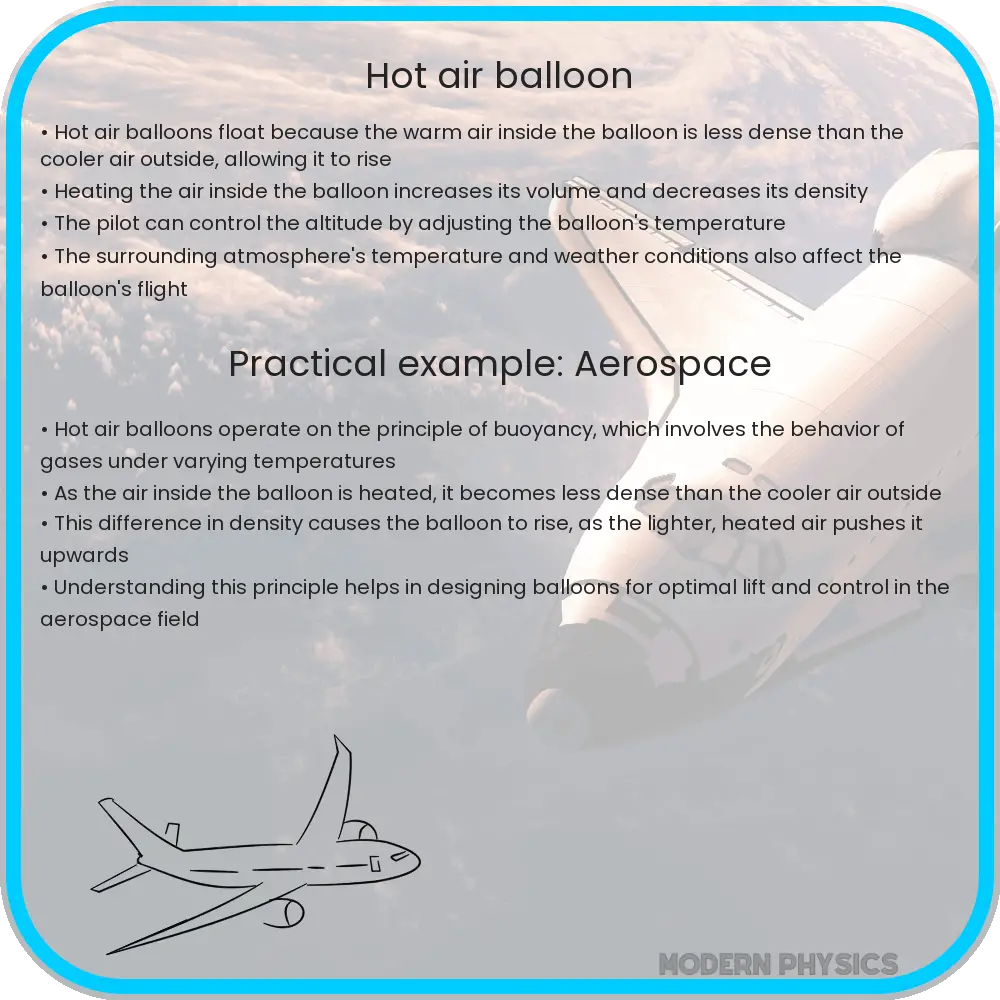Explore the physics of hot air balloons, covering buoyancy, thermodynamics, and kinematics, to understand their serene, scenic flight.

Understanding Hot Air Balloon Dynamics: Vertical Motion and Kinematics
Hot air balloons offer a serene and picturesque form of flight, capturing the imagination with their gentle ascent and colorful presence in the sky. The science behind their vertical motion and kinematics is both fascinating and complex, involving principles of thermodynamics and fluid mechanics.
The Principle of Buoyancy
At the heart of hot air balloon dynamics is the principle of buoyancy. This principle, first formalized by Archimedes, states that an object in a fluid experiences an upward force equal to the weight of the fluid it displaces. In the context of hot air balloons, the ‘fluid’ is the surrounding air. When the air inside the balloon is heated, it becomes less dense than the cooler air outside. This decrease in density causes the balloon to displace more air and, thus, experience a greater upward buoyant force.
Heating the Air
To achieve lift, hot air balloons use burners that expel flames to heat the air inside the envelope (the balloon part). This heating process relies on the ideal gas law, expressed as PV = nRT, where P stands for pressure, V for volume, n for the number of moles of gas, R for the ideal gas constant, and T for temperature. As the temperature (T) inside the balloon increases, the air expands, causing a decrease in its density (ρ), which is inversely proportional to the volume (V).
Controlled Ascent and Descent
Pilots control the vertical motion of the balloon by regulating the temperature of the air inside the envelope. Increasing the temperature causes the balloon to rise, while allowing the air to cool makes it descend. This control is achieved by adjusting the flame intensity of the burners.
The Role of Ambient Temperature and Altitude
Ambient temperature and altitude also play crucial roles in balloon dynamics. Colder outside temperatures can enhance lift, as the temperature difference between the inside and outside air increases. However, at higher altitudes, the thinner air exerts less buoyant force, requiring higher internal temperatures to maintain altitude.
Hot air balloon flight also exemplifies an application of kinematics, the branch of physics that deals with motion without considering the forces that cause it. The vertical trajectory of the balloon can be analyzed using kinematic equations, considering factors like initial velocity, acceleration due to buoyancy, and the force of gravity.
Kinematic Equations and Vertical Trajectory
The vertical motion of a hot air balloon can be understood through kinematic equations, which describe the motion of objects. Assuming the air resistance is negligible, the primary forces acting on the balloon are the buoyant force and gravity. The kinematic equations, which include variables such as displacement (s), initial velocity (u), final velocity (v), acceleration (a), and time (t), can be applied to describe the balloon’s ascent and descent. For instance, the equation \( s = ut + \frac{1}{2}at^2 \) helps predict the height reached over a period of time under constant acceleration.
Energy Considerations
Energy plays a crucial role in the dynamics of hot air balloons. The burner converts the chemical energy of the fuel (typically propane) into thermal energy, which heats the air. This process increases the internal energy of the air molecules, causing them to move more vigorously and expand. This expansion, in turn, decreases the air density inside the balloon, creating lift. The conservation of energy principle is key to understanding how much fuel is needed for a flight and how changes in energy affect the balloon’s behavior.
Environmental Impact
While hot air balloons are a low-impact form of aviation, they still have environmental considerations. The combustion of propane releases carbon dioxide (CO2) and water vapor into the atmosphere. However, compared to other forms of air transport, balloons are relatively eco-friendly due to their lower fuel consumption and slower speeds.
Conclusion
Hot air ballooning is a unique blend of adventure and science. Understanding the dynamics of these majestic aircraft involves a grasp of buoyancy, thermodynamics, and kinematics. The interplay of these scientific principles allows balloons to gracefully navigate the skies. Pilots must consider numerous factors, including air temperature, altitude, and fuel consumption, to control the balloon’s vertical motion effectively. As an embodiment of human ingenuity and the pursuit of flight, hot air balloons not only provide a tranquil and scenic experience but also serve as a fascinating case study in the application of physics in real-world scenarios.
